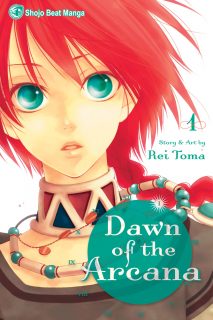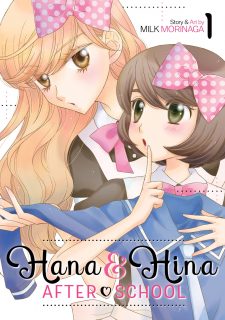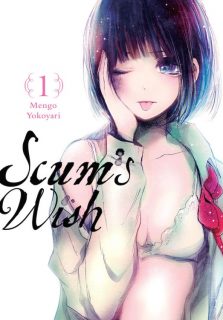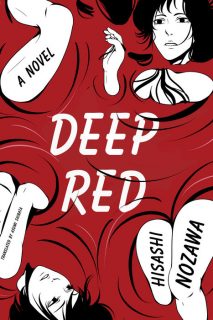My News and Reviews
As regular readers of Experiments in Manga know, on the last Wednesday of every month I host a giveaway of some sort (usually manga-related) for which participants have a week to submit their entries. This time around the monthly giveaway is for the first volume of Coolkyousinnjya’s surprisingly delightful Miss Kobayashi’s Dragon Maid. The winner will be announced this coming Wednesday, so you can still enter for a chance to win if you haven’t already. Also later this week, look for another guest review by my friend and fellow yuri manga fan Jocilyn. Elsewhere in the Manga Bookshelf sphere of blogs, The Manga Critic has started a monthly manga review index. There have been similar features in the past, perhaps most notably at MangaBlog, and I’ve always found them incredibly useful and valuable, so I’m glad to see Kate Dacey taking it on. Also in general, I highly recommend the content at The Manga Critic–Kate’s actually one of my major inspirations when it comes to manga blogging.
As for other interesting things I’ve come across recently: Chic Pixel’s Anne Lee has posted a really fantastic list of bibliographic resources for those curious about the academic study of boys’ love. (I’ve read quite a few books and articles myself, and even reviewed Jeffery Angles’ Writing the Love of Boys: Origins of Bishōnen Culture in Modernist Japanese Literature at Experiments in Manga a few years ago.) And if that’s not enough of BL studies for you, J. R. Brown has posted the slides from her Anime Boston panel “Boys’ Love, Otome Culture, and Gender” which covers everything from the origin of shoujo manga to gay comics and more. On their own the slides are fairly informative, but I’m looking forward to seeing the annotated version, too.
Also at Anime Boston, Viz Media made quite a few licensing announcements. Some were digital-only while others were digital-first or print-only. Here’s a quick list of the books that will eventually make their way into print: Kenta Shinohara’s Astra Lost in Space, Abi Umeda’s Children of Whales (I’m particularly curious about this series), an omnibus edition of Tsugumi Ohba and Takeshi Obata’s Death Note collecting the entire series and a bonus epilogue in a single volume, Nisioisin’s Hikaru Nakamura’s novel Juni Taisen: Zodiac Warriors (I’m not familiar with the novel, but the creators involved have certainly caught my attention), Kenji Taira’s Naruto: Chibi Sasuke’s Sharingan Legend, Kaiu Shirai and Posuka Demizu’s The Promised Neverland (which is supposed to be fantastic), a collection of nine Junji Ito stories and accompanying material selected by Ito himself called Shiver (always glad to see more Ito being released in English), Maki Enjoji’s SP Baby, and Sui Ishida’s artbook Tokyo Ghoul Illustrations.
A couple of Kickstarter projects recently launched which may be of interest as well: All the Anime/Anime Limited is joining forces with Studio 4°C to create a home video release of Masaaki Yuasa’s directorial debut Mind Game. Digital Manga has entered the fray again with a campaign to release more of Osamu Tezuka’s manga in print: Ambassador Magma, Dust 8, The Euphrates Tree, Metamorphose, Say Hello to Bookila, The Thief Inoue Akikazu, Wonder 3, and Yakeppachi’s Maria. It looks as though the print runs will be very limited and Kickstarter may be the only way to get a hold of some of the titles. (I have to admit, I certainly have my qualms about Digital Manga’s business practices in general and over-reliance on crowdfunding specifically. The quality of Digital Manga’s releases has really gone downhill over the last few years, too. Honestly, I’ve lost most of my confidence in the company as a publisher, but it’s managed not to completely go under yet.)
Quick Takes
 Dawn of the Arcana, Volumes 1-6 by Rei Toma. I generally enjoy epic fantasy of the shoujo variety, so I’m not entirely sure why it’s taken me so long to finally get around to reading Dawn of the Arcana. So far, I’m enjoying the manga tremendously. Nakaba is a princess who has been married off to a prince of the neighboring kingdom despite her questionable ancestry in a half-hearted attempt to secure peace between the two countries. But instead, gifted with the ability to see both into the past and into the future, Nakaba may find herself in the unlikely position of leading a revolution. Dawn of the Arcana does come across as a rather typical example of high fantasy–all the way down to the heroine’s fiery red hair–but even though it hasn’t really made itself stand out yet, the manga is a solid series. I greatly enjoyed the manga’s mix of court and political intrigue, action, and complicated interpersonal relationships. Much like the story, the artwork tends to be somewhat standard although attractive. Toma’s backgrounds are generally fairly sparse, but the details put into things like the characters’ clothing is lovely. I definitely look forward to reading more of Dawn of the Arcana in the very near future.
Dawn of the Arcana, Volumes 1-6 by Rei Toma. I generally enjoy epic fantasy of the shoujo variety, so I’m not entirely sure why it’s taken me so long to finally get around to reading Dawn of the Arcana. So far, I’m enjoying the manga tremendously. Nakaba is a princess who has been married off to a prince of the neighboring kingdom despite her questionable ancestry in a half-hearted attempt to secure peace between the two countries. But instead, gifted with the ability to see both into the past and into the future, Nakaba may find herself in the unlikely position of leading a revolution. Dawn of the Arcana does come across as a rather typical example of high fantasy–all the way down to the heroine’s fiery red hair–but even though it hasn’t really made itself stand out yet, the manga is a solid series. I greatly enjoyed the manga’s mix of court and political intrigue, action, and complicated interpersonal relationships. Much like the story, the artwork tends to be somewhat standard although attractive. Toma’s backgrounds are generally fairly sparse, but the details put into things like the characters’ clothing is lovely. I definitely look forward to reading more of Dawn of the Arcana in the very near future.
 Hana & Hina After School, Volume 1 by Milk Morinaga. I believe that Morinaga is currently the most well-represented yuri manga creator available in English. So far, five of Morinaga’s manga have been translated, the most recent being Hana & Hina After School. Interestingly, in Japan the manga was serialized in a magazine aimed at a general audience rather than one specifically catering to yuri fans. The titular Hana and Hina are two young women working part time at a store specializing in cute character goods even though their high school forbids its students from holding jobs. The story follows their relationship as they become friends and slowly realize that their feelings may evolve into something else. Like most of Morinaga’s other manga that I’ve read, Hana & Hina After School tends to be rather cute and sweet. The series is enjoyable and pleasant even if it is at times a little silly and somewhat unbelievable. However, the end of the first volume does introduce some sobering concerns when Hina is confronted by a few of her classmates homophobia, an unfortunate reality that many yuri manga tend to gloss over or ignore entirely in favor of pure fantasy. (Granted, that fantasy is important to have, too.)
Hana & Hina After School, Volume 1 by Milk Morinaga. I believe that Morinaga is currently the most well-represented yuri manga creator available in English. So far, five of Morinaga’s manga have been translated, the most recent being Hana & Hina After School. Interestingly, in Japan the manga was serialized in a magazine aimed at a general audience rather than one specifically catering to yuri fans. The titular Hana and Hina are two young women working part time at a store specializing in cute character goods even though their high school forbids its students from holding jobs. The story follows their relationship as they become friends and slowly realize that their feelings may evolve into something else. Like most of Morinaga’s other manga that I’ve read, Hana & Hina After School tends to be rather cute and sweet. The series is enjoyable and pleasant even if it is at times a little silly and somewhat unbelievable. However, the end of the first volume does introduce some sobering concerns when Hina is confronted by a few of her classmates homophobia, an unfortunate reality that many yuri manga tend to gloss over or ignore entirely in favor of pure fantasy. (Granted, that fantasy is important to have, too.)
 Scum’s Wish, Volumes 1-2 by Mengo Yokoyari. I wasn’t initially planning to pick up Scum’s Wish, but after reading a few positive reviews of the series I decided to give it a try after all. The cover art of the first volume is deliberately provocative, but the manga isn’t nearly as salacious as it might imply. In fact, the series can actually be surprisingly contemplative. Scum’s Wish is a manga about unrequited love. Almost every character in the series is pining for someone with whom an involved romance would seem to be impossible or at least inadvisable, resulting in a complex web of personal relationships fraught with loneliness and anguish. (There is one heck of a love polygon going on in Scum’s Wish and nearly everyone who is introduced is connected to it somehow.) Hanabi is in love with Narumi, her childhood friend who now also happens to be her homeroom teacher. Mugi is in love with Akane, a music instructor who used to be his tutor. Recognizing that they are suffering under very similar circumstances and hoping to ease some of the pain, Hanabi and Mugi agree to find comfort in a relationship together. Neither one of them is in love with the other, but they are both aware of and take advantage of that fact.
Scum’s Wish, Volumes 1-2 by Mengo Yokoyari. I wasn’t initially planning to pick up Scum’s Wish, but after reading a few positive reviews of the series I decided to give it a try after all. The cover art of the first volume is deliberately provocative, but the manga isn’t nearly as salacious as it might imply. In fact, the series can actually be surprisingly contemplative. Scum’s Wish is a manga about unrequited love. Almost every character in the series is pining for someone with whom an involved romance would seem to be impossible or at least inadvisable, resulting in a complex web of personal relationships fraught with loneliness and anguish. (There is one heck of a love polygon going on in Scum’s Wish and nearly everyone who is introduced is connected to it somehow.) Hanabi is in love with Narumi, her childhood friend who now also happens to be her homeroom teacher. Mugi is in love with Akane, a music instructor who used to be his tutor. Recognizing that they are suffering under very similar circumstances and hoping to ease some of the pain, Hanabi and Mugi agree to find comfort in a relationship together. Neither one of them is in love with the other, but they are both aware of and take advantage of that fact.
 Deep Red by Hisashi Nozawa. Although perhaps best known as a screenwriter, Nozawa was also recognized as an accomplished novelist. Deep Red, which earned Nozawa an Eiji Yoshikawa Prize in 2001, is his first novel to be released in English. Kanako is the only survivor of the mass murder of her family, simply because she happened to be away on a school trip when her parents and two younger brothers were killed. Understandably, their deaths have left a great wound, but Kanako isn’t the only one left troubled and hurt–the life of Miho, the daughter of the murderer, has also been irrevocably changed. At times, Deep Red is uncomfortably voyeuristic and there’s a peculiar fixation on Kanako’s body and sex life with her boyfriend. I was never entirely convinced by Kanako as a character, either. However, Deep Red does provide an interesting psychological exploration of hate, anger, and misplaced revenge. The novel is instantly engaging. However, the middle portion of the narrative is repetitive and does drag a fair bit; I admittedly started to lose my interest and patience with the story. But once Kanako becomes obsessed with and decides to pursue Miho, Deep Red picks up speed again and the novel’s ending is very satisfying.
Deep Red by Hisashi Nozawa. Although perhaps best known as a screenwriter, Nozawa was also recognized as an accomplished novelist. Deep Red, which earned Nozawa an Eiji Yoshikawa Prize in 2001, is his first novel to be released in English. Kanako is the only survivor of the mass murder of her family, simply because she happened to be away on a school trip when her parents and two younger brothers were killed. Understandably, their deaths have left a great wound, but Kanako isn’t the only one left troubled and hurt–the life of Miho, the daughter of the murderer, has also been irrevocably changed. At times, Deep Red is uncomfortably voyeuristic and there’s a peculiar fixation on Kanako’s body and sex life with her boyfriend. I was never entirely convinced by Kanako as a character, either. However, Deep Red does provide an interesting psychological exploration of hate, anger, and misplaced revenge. The novel is instantly engaging. However, the middle portion of the narrative is repetitive and does drag a fair bit; I admittedly started to lose my interest and patience with the story. But once Kanako becomes obsessed with and decides to pursue Miho, Deep Red picks up speed again and the novel’s ending is very satisfying.